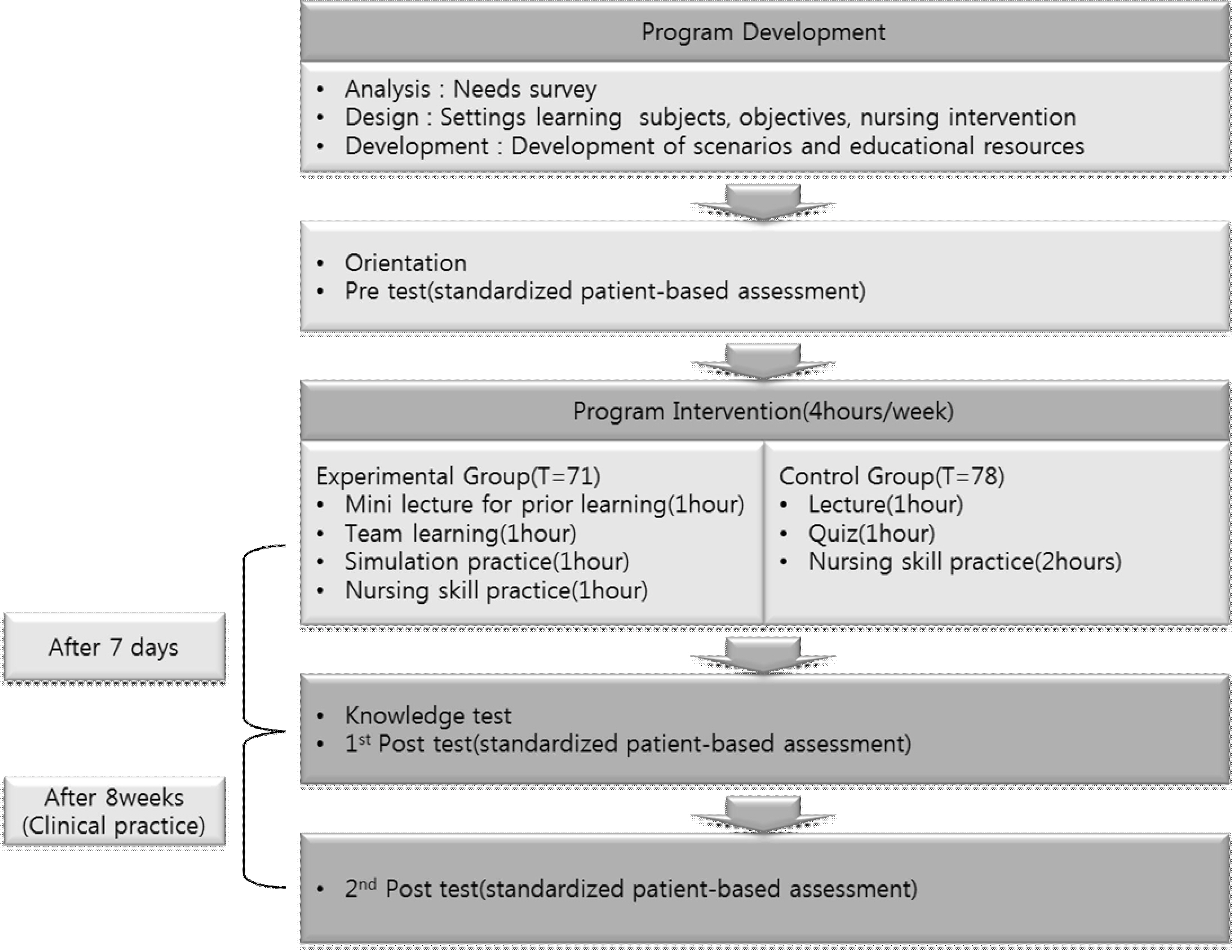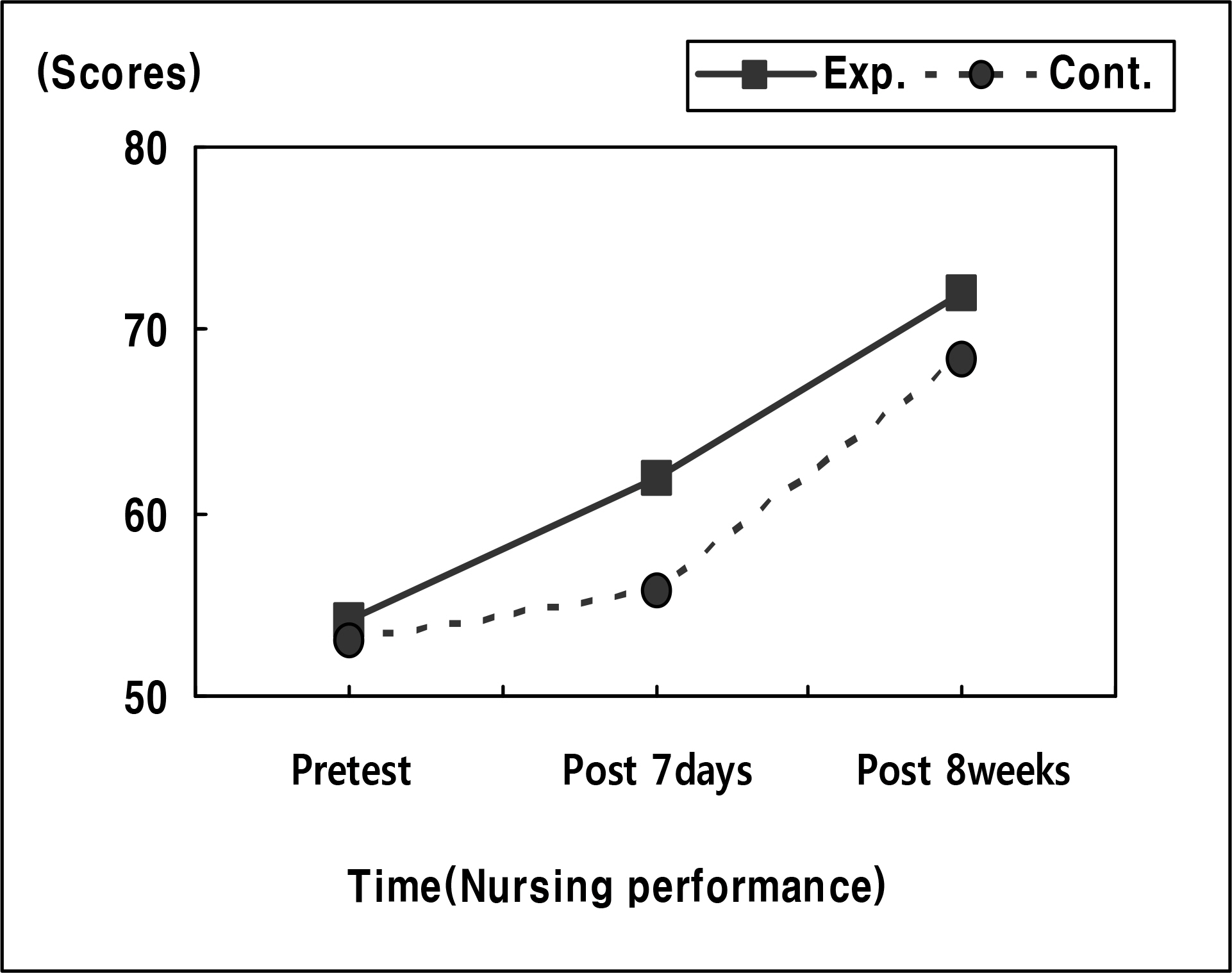1Mokpo Christian Hospital, Mokpo
2Department of Nursing, HonamUniversity, Gwangju, Korea
Copyright © 2015 Korean Society of Adult Nursing
This is an Open Access article distributed under the terms of the Creative Commons Attribution Non-Commercial License (http://creativecommons.org/licenses/by-nc/3.0) which permits unrestricted non-commercial use, distribution, and reproduction in any medium, provided the original work is properly cited.
| Variables | Groups | Exp. (n=71) | Cont. (n=78) | t† | p | Source | F‡ | p |
|---|---|---|---|---|---|---|---|---|
| M±SD | M±SD | |||||||
| Knowledge | Post 7 days | 8.18±1.13 | 6.52±1.61 | 11.94 | < .001 | |||
| Clinical | Pretest | 54.07±5.96 | 53.05±4.99 | 1.14 | .258 | Group | 194.58 | < .001 |
| Performance | Post 7 days | 61.92±7.90 | 55.87±5.47 | 8.94 | < .001 | Time | 176.55 | < .001 |
| Post 8 weeks | 72.07±3.77 | 68.41±4.82 | 23.35 | < .001 | Group×Time | 101.01 | < .001 |



Learning Subjects, Objectives, Core Nursing Intervention Of the Scenario
| Scenario | Learning subjects | Learning objectives | Core nursing intervention | |
|---|---|---|---|---|
| Scenario I | Indication | Knowledge |
․ Be able to know the definition and purpose of colonoscopy. ․ Be able to find the related information by analyzing and integrating various materials for the assessment of an examine |
․ Implement physical examinations. ․ Implement pain assessments. ․ Interview. ․ (history, family history, medication history, present illness) ․ Explain about the purpose of diagnostic checks and physical examinations. |
| Skill | ․ Be able to assess the physical status and health of the examinee. | |||
| Attitude | ․ Be able to show the appearance of doing our best to the examinee. | |||
| Scenario II | Nursing before & after colonoscopy | Knowledge |
․ Analyze and integrate various patient materials necessary for nursing before and after the colonoscopy. ․ Be able to understand how to take cleaning medicines and precautions related to them. |
․ Implement pre-examinations educations. ․ Identify examination consent forms. ․ Explain about the intestine cleaning medicines. (directions, notices, side effects) ․ Explain about the activities after taking the intestine cleaning medicines. ․ Implement the infusion of aqueous solution into veins. ․ Explain about the examination processes. ․ Implement the post-examination educations |
| Skill |
․ Be able to implement nursing educations before and after the colonoscopy. ․ Be able to explain and educate about the prescribed intestine cleaning medicines. ․ Be able to administer the prescribed medicines. |
|||
| Attitude |
․ Apply therapeutic communication skills before and after the colonoscopy. ․ Be able to explain about related matters so that the examinee can understand them. |
|||
| Scenario III | Emergency care for bleeding after colonoscopy | Knowledge |
․ Analyze and integrate various patient materials necessary in emergency related to the colonoscopy. ․ Be able to find the signs of bleeding and analyze various information. ․ Be able to explain and find the side effects of blood transfusion. |
․ Implement the blood transfusion-related educations. ․ Start the blood transfusion and identify patient's side effects. ․ Stop the blood transfusion and connect normal saline. ․ Report to doctors. ․ Explain to the examinee and do emotional supports. |
| Skill |
․ Be able to implement the nursing for blood transfusion. ․ Be able to identify the side effects of blood transfusion and apply core nursing skills. |
|||
| Attitude |
․ Be able to apply therapeutic communication skills to the examinee in emergency. ․ Be able to do emotional supports. |
|||
Homogeneity Test on Demographic and Clinical Characteristics of Subjects (N=149)
| Characteristics | Categories | Exp. (n=71) | Cont. (n=78) | x2 or t | p |
|---|---|---|---|---|---|
| n (%) or M±SD | n (%) or M±SD | ||||
| Age (year) | 22.48±0.88 | 22.56±0.78 | -0.63 | .532 | |
| Gender | Male | 10 (14.1) | 12 (15.4) | 2.82 | .204 |
| Female | 61 (85.9) | 66 (84.6) | |||
| The motivation for admission to nursing | To get a job | 41 (57.7) | 33 (42.3) | 3.55 | .169 |
| Other choice | 15 (21.1) | 23 (29.5) | |||
| Self choice | 15 (21.1) | 22 (28.2) | |||
| Satisfaction with major | High | 10 (14.1) | 5 (6.4) | 2.43 | .297 |
| Medium | 27 (38.0) | 33 (42.3) | |||
| Low | 34 (47.9) | 40 (51.3) | |||
| Satisfaction with school life | High | 20 (28.2) | 23 (29.5) | 1.62 | .654 |
| Medium | 44 (62.0) | 43 (55.1) | |||
| Low | 7 (9.9) | 12 (15.4) | |||
| Satisfaction with clinical practice | High | 5 (7.0) | 6 (7.7) | 0.74 | .692 |
| Medium | 22 (31.0) | 29 (37.2) | |||
| Low | 44 (62.0) | 43 (55.1) | |||
| Accumulated last semester grade | 4.00~4.50 | 7 (9.9) | 11 (14.1) | 3.70 | .296 |
| 3.51~3.99 | 29 (40.8) | 36 (46.2) | |||
| 3.00~3.50 | 30 (42.3) | 22 (28.2) | |||
| ≤ 2.51 | 5 (7.0) | 9 (11.5) |
Exp.=experimental group; Cont.=control group.
Comparison of Nursing Performance between the Groups (N=149)
| Variables | Groups | Exp. (n=71) | Cont. (n=78) | t |
p | Source | F |
p |
|---|---|---|---|---|---|---|---|---|
| M±SD | M±SD | |||||||
| Knowledge | Post 7 days | 8.18±1.13 | 6.52±1.61 | 11.94 | < .001 | |||
| Clinical | Pretest | 54.07±5.96 | 53.05±4.99 | 1.14 | .258 | Group | 194.58 | < .001 |
| Performance | Post 7 days | 61.92±7.90 | 55.87±5.47 | 8.94 | < .001 | Time | 176.55 | < .001 |
| Post 8 weeks | 72.07±3.77 | 68.41±4.82 | 23.35 | < .001 | Group×Time | 101.01 | < .001 |
Exp.=experimental group; Cont.=control group;
†t-test;
‡Repeated Measure ANOVA.
Exp.=experimental group; Cont.=control group.
Exp.=experimental group; Cont.=control group; t-test; Repeated Measure ANOVA.

